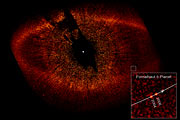The study of exoplanets and protoplanetary discs
 |
| Fomalhaut b, visible as a tiny speck in this image, is the first exoplanet to have been imaged in visible light. |
Hubble's high resolution has been indispensable in the investigation of the gas and dust disks, dubbed proplyds, around the newly born stars in the Orion Nebula. The proplyds may very well be young planetary systems in the early stages of creation. There is further information on proplyds in the section on the formation of stars.
The first detection of an atmosphere around an extrasolar planet was seen in a gas-giant planet orbiting the yellow, Sun-like star HD 209458, 150 light-years from Earth. The planet was not seen directly by Hubble. Rather, the presence of sodium as well as evaporating hydrogen, oxygen and carbon was detected in light filtered through the planet's atmosphere when it passed in front of its star as seen from Earth.
The details revealed by Hubble are superior to anything seen to date with ground-based instruments, and thanks to Hubble we have visual proof today that dusty disks around young stars are common.
Hubble has been instrumental in studying these extra-solar planets but it has also helped to detect them as well. In 2008, Hubble made an image of the planet Fomalhaut b, a gas giant planet about three times the mass of Jupiter, which orbits the star Fomalhaut. This was the first ever image made of an exoplanet in visible light. Within the same year the first organic molecule on an extrasolar planet was detected by Hubble.
In 2012 Hubble even discovered a complete new type of extra-solar planet: a waterworld enshrouded by a thick, steamy atmosphere. Later Hubble was able to measure for the first time the colour and to create the most detailed weather map an exoplanet.
In 2016 astronomers used Hubble to analyse the atmosphere of a rocky super-Earth exoplanet for the first time. These findings both showed the capabilities and the limitations of Hubble and the need for an even more advanced space telescope.
But Hubble does not only study exoplanets: In 2018 astronomers were able to find compelling evidence for the first exomoon. Data gathered with Hubble indicated an exomoon the size of Neptune, in a stellar system 8000 light-years from Earth.
Related videos and images
- Hubblecast 22: Hubble directly observes planet orbiting Fomalhaut
- Hubblecast 97: Hubble, exoplanets and the hunt for life
- Hubblecast 102: Taking the fingerprints of exoplanets
Related news releases
- European astronomers observe first evaporating planet (2003)
- Planet or failed star? (2006)
- Hubble finds 16 candidate extrasolar planets far across our galaxy (2006)
- Hubble observations confirm that planets form from disks around stars (2006)
- Hubble finds first organic molecule on extrasolar planet (2008)
- Hubble directly observes planet orbiting Fomalhaut (2008)
- Hubble finds carbon dioxide on an extrasolar planet (2008)
- Hubble reveals a new class of extrasolar planet (2012)
- Hubble spots azure blue planet (2013)
- Hubble reveals most detailed exoplanet weather map ever (2014)
- Hubble sees atmosphere being stripped from Neptune-sized exoplanet (2015)
- Hubble manages first detection of super-Earth atmosphere (2016)
- Hubble finds exocomet breaking apart (2017)
- Hubble observes pitch black planet (2017)
- Hubble delivers first hints of possible water content of TRAPPIST-1 planets (2017)
- Hubble observes exoplanet atmosphere in more detail than ever before (2018)
- Hubble finds compelling evidence for first exomoon (2018)